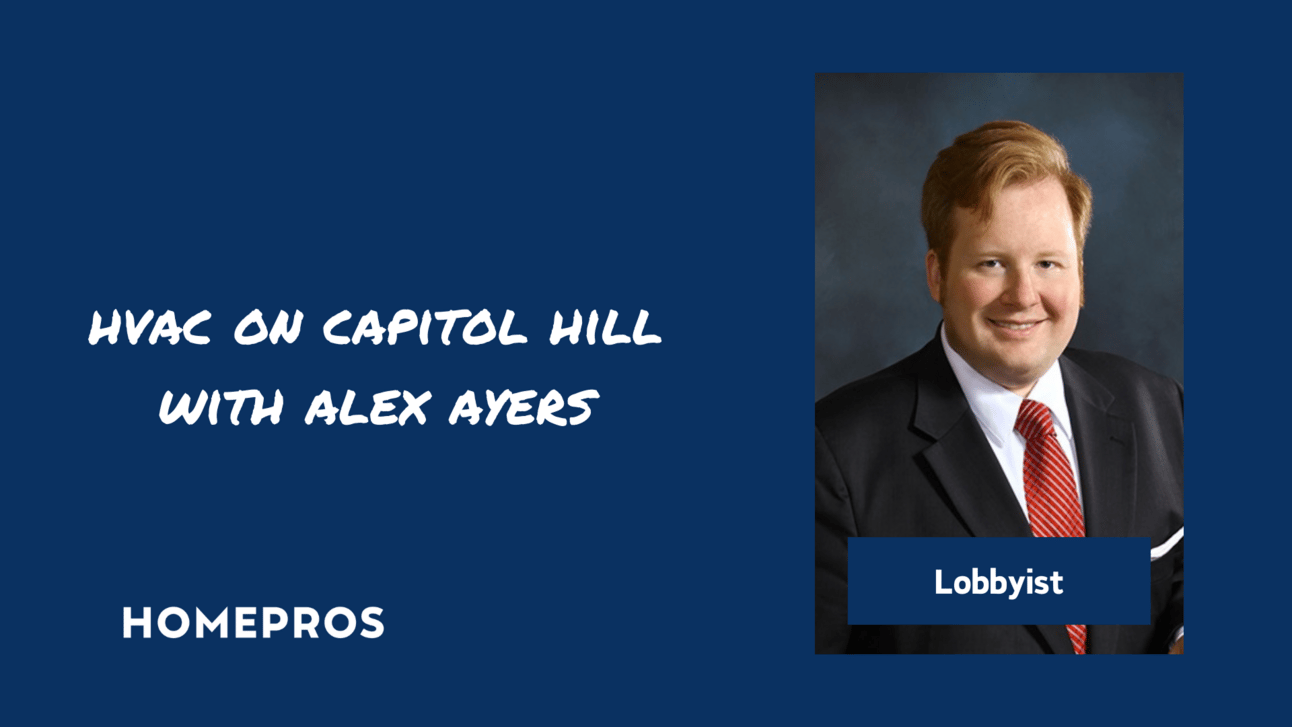Talking HVAC on Capitol Hill with industry lobbyist Alex Ayers
Notes on the Inflation Reduction Act, the refrigerant phase-down, and HVAC-related legislation

❝
A lot of contractors that were around for the R-22 phase-out think this is the same process, but it’s way different.
Alex Ayers is the Vice President of Government Affairs at HARDI and one of the HVAC industry’s primary lobbyists. He’s had a long-time love for lobbying, has midwestern roots, and stands for the industry daily on Capitol Hill.
We talked about the Inflation Reduction Act, the refrigerant phase-down, and what else contractors should know about HVAC-related legislation.
How does one end up as a lobbyist in the HVAC industry?
When I was 14, I got to go to a “State Capitol day.” One of the speakers was a state-level lobbyist, and I thought it was the most amazing job in the world. I wanted to be a lobbyist since then. I started lobbying in 2012 and got recruited by HARDI in 2017.
Can you talk to me about the residential-focused pieces of legislation?
[On the Inflation Reduction Act (IRA)], we have a lot of information, but we don’t have a lot of details — especially on the rebate side. State implementation is what we’re waiting on. Until we have it, we can only start preparing. For the HEAR program, states can use an API for homeowner income verification, and a lot of details are very important, we just don’t know them yet.
[On the AIM Act], the EPA was given a monumental task, and people there are learning more about HVAC than ever before. A lot of contractors that were around for the R-22 phase-out think this is the same process, but it’s way different. With R-22, we looked at physical pounds produced and brought it down. With HFCs (R-410A), what’s decreasing is the number of “building blocks” — which are a measure of the products’ global warming impact, defined as GWP — required to produce a pound.
Why is it taking so long to get the necessary details about rebate programs?
States are slow because they have to learn these new programs and they also need more clarification from the Department of Energy (DOE) on the map they laid out. The back and forth takes time — between states and the DOE. They also have to shift time with existing workers because they have other stuff to work on. They’re not intentionally slow, they just don’t have the capacity.
What are the biggest risks with all of this?
For the HEAR program, the biggest risk is the time from when a project is completed to when the contractor gets paid. All we know as of now is that the DOE requires contractors to be paid “within 4 weeks.” We’re trying to get states to basically escrow the money and get it to contractors in a matter of days — because if it's weeks, contractors won’t participate, and if they don’t, the program fails.
With the AIM Act, it was install deadlines. We generally hate install deadlines, because you affect inventory — after the deadline, any remaining inventory becomes uninstallable. Pushing back the deadline a year — the sell-through period to 2026 — was a win for us. It’s still not the perfect scenario, but it’s much better than what it was.
What are the best resources for contractors to track program progress within their state?
The best option for the refrigerant phase-out is the EPA’s website. For the IRA (tax credits and rebates), it’s their state energy offices. Hopefully, the states are updating those.
Why is the government so slow, in general?
I wish I had a good answer; the government is just slower than businesses at changing things. Part of the reason the rebate programs are slow is because the IRA was created under reconciliation — which removes any component of a bill that’s unrelated to spending, taxes, and revenue.
So we couldn’t say, “The federal government is creating a program to incentivize heat pumps.” Instead, the way around it was to create a program that funds states to create their own programs that incentivize heat pumps — and we can provide initial guidance.
What does your typical day look like?
Meeting with Congress members and other stakeholders in the industry, and understanding how efficiency changes are gonna affect OEMs — and in turn, HARDI distributors and then contractors and homeowners.
The most consistent part of the job is the amount of reading I have to do — news, proposed regulations, and staying up to date on all of that.
How do you personally think these programs will play out?
We assumed the states with existing [heat pump] programs would apply first, like California. But we actually got news from the DOE on state application statuses, and it includes a tracker!
→ See here
Do you have any personal interests outside of DC?
I got back into trap shooting during Covid; I did it in high school. I’m in a winter league now and we’ll be competing every Sunday.
And I’ve always wanted to do clay pottery on a wheel.
If you could have dinner with anyone in history, who would it be?
This is cliche because I work in politics, but someone like Alexander Hamilton. I’d want to know what he and the Founders’ thoughts were when designing the governmental system we have. How truly in-depth were they thinking? And could they have realized their impact on today, 250 years later?
📬 Get our stories in your inbox
Keep reading
Carrier, Lennox report Q3 earnings
October 30, 2023
The ‘big, beautiful bill’: What’s in it for contractors
The legislation, now on its way to the Senate, proposes a handful of changes that impact contractors, including key tax incentives


